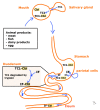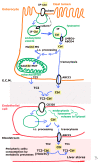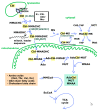Vitamin B12 (Cobalamin): Its Fate from Ingestion to Metabolism with Particular Emphasis on Diagnostic Approaches of Acquired Neonatal/Infantile Deficiency Detected by Newborn Screening
- PMID: 36422244
- PMCID: PMC9698159
- DOI: 10.3390/metabo12111104
Vitamin B12 (Cobalamin): Its Fate from Ingestion to Metabolism with Particular Emphasis on Diagnostic Approaches of Acquired Neonatal/Infantile Deficiency Detected by Newborn Screening
Abstract
Acquired vitamin B12 (vB12) deficiency (vB12D) of newborns is relatively frequent as compared with the incidence of inherited diseases included in newborn screening (NBS) of different countries across the globe. Infants may present signs of vB12D before 6 months of age with anemia and/or neurologic symptoms when not diagnosed in asymptomatic state. The possibility of identifying vitamin deficient mothers after their pregnancy during the breastfeeding period could be an additional benefit of the newborn screening. Vitamin supplementation is widely available and easy to administer. However, in many laboratories, vB12D is not included in the national screening program. Optimized screening requires either second-tier testing or analysis of new urine and blood samples combined with multiple clinical and laboratory follow ups. Our scope was to review the physiologic fate of vB12 and the pathobiochemical consequences of vB12D in the human body. Particular emphasis was put on the latest approaches for diagnosis and treatment of vB12D in NBS.
Keywords: cobalamin deficiency; diagnostic approaches; newborn screening; vitamin B12 deficiency.
Conflict of interest statement
The authors declare no conflict of interest.
Figures




References
-
- Harrington D.J. Laboratory Assessment of Vitamin Status. Elsevier; Amsterdam, The Netherlands: 2019. Methods for Assessment of Vitamin B12; pp. 265–299.
-
- Lederer A.-K., Hannibal L., Hettich M., Behringer S., Spiekerkoetter U., Steinborn C., Gründemann C., Zimmermann-Klemd A.M., Müller A., Simmet T. Vitamin B12 Status upon Short-Term Intervention with a Vegan Diet—A Randomized Controlled Trial in Healthy Participants. Nutrients. 2019;11:2815. doi: 10.3390/nu11112815. - DOI - PMC - PubMed
Publication types
LinkOut - more resources
Full Text Sources
Research Materials
Miscellaneous

